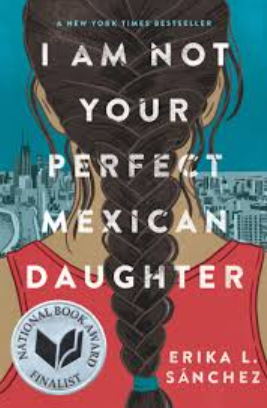Book Review: I am Not Your Perfect Mexican Daughter
1.
BIBLIOGRAPHY
SANCHEZ, E. L. (2017). I am not your perfect Mexican
daughter. EMBER.
ISBN: 978-1524700515
2. PLOT SUMMARY
Perfect Mexican daughters do not go away to college.
And they do not move out of their parents’ house after high school graduation.
Perfect Mexican daughters never abandon their family.
But Julia is not your perfect Mexican daughter. That
was Olga’s role.
Then a tragic accident on the busiest street in
Chicago leaves Olga dead and Julia left behind to reassemble the shattered
pieces of her family. And no one seems to acknowledge that Julia is broken,
too. Instead, her mother seems to channel her grief into pointing out every
possible way Julia has failed.
But it’s not long before Julia discovers that Olga
might not have been as perfect as everyone thought. With the help of her best
friend Lorena, and her first love, first everything boyfriend Connor, Julia is
determined to find out. Was Olga really what she seemed? Or was there more to
her sister’s story? And either way, how can Julia even attempt to live up to a
seemingly impossible ideal?
3.
CRITICAL ANALYSIS
I have a love-hate relationship with this book.
Although the storyline was engaging, and I could see much of myself in Julia,
I think this story was a bit stereotypical. For example, this book is
titled “I Am Not Your Perfect Mexican Daughter. The name alone felt stereotypical.
What is a perfect Mexican daughter, and why does Julia feel she is not perfect?
Was it because she aspired to go to college and liked going and was the complete
opposite of her dead sister? This doesn’t represent the “Mexican” culture. I am
Mexican American, and I am a first-generation college graduate, and I will soon
have my Masters; my parents always instilled the importance of a college
education and always encouraged me to do more. I think the way they described
Julia’s parents was in an old-fashioned way of thinking that doesn’t accurately
represent the “Mexican” culture.
Some aspects of this novel were relatable, like Julia’s
relationship with her mother, which is typical given the age group and the
grief and personal struggles she faced after losing her sister to a tragic
accident. I also thought how they depicted the gang violence during Julia’s
visit to Mexico was pointless, as were some of the other topics that were
touched on in this book. Yes, we all know that there is a lot of cartel violence
in Mexico, but the way it was mentioned in this book, I thought, was pointless
and could have been left out. That detail didn’t add to the plotline.
All the negatives aside, I like the way Sanchez
touched on Julia’s mourning process and how Julia’s character acknowledged her
grief. Because this story was told from Julia’s perspective, readers were able
to understand what she was going through.
4.
REVIEW EXCERPT(S)
*National Book Award Finalist
Starred review in Booklist: “An earnest and heartfelt
tale.”
Starred review in SLJ: “A timely and must-have account
of survival in a culturally contested world.”
5.
CONNECTIONS
* Have students create a story map for this novel
using a technology app such as Jamboard, Nearpod, or StoryMaps. This story map
should detail the story's beginning, middle, and ending, along with rising and
falling actions. The students should share their finished product with the
class.
* People who liked this novel, would also enjoy these
titles:
Chavez Macias, A. (2022). Big chicas don’t cry.
Montlake. ISBN: 978-1542039291
Chavez Macias, A. (2023). Too soon for adiós.
Montlake. ISBN: 978-1542039307



Comments
Post a Comment